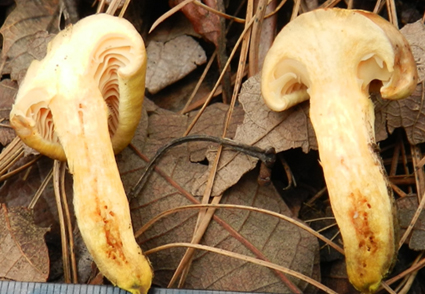Abstract
The genus Chroogomphus has scarcely been studied in Mexico, with only one species reported in the country despite its great biocultural importance in native cultures. In this study, two new species of Chroogomphus are presented based on genetic and morphological characterization. The phylogenetic analysis with DNA sequences from nrITS region confirmed that C. conacytiensis sp. nov. and C. flavovinaceus sp. nov. are included in independent clades separated from other species within the subgenus Chroogomphus. Both species have great biocultural importance in the Tlahuica-Pjiekakjoo native culture from Central Mexico as edible taxa, and are associated with Pinus pseudostrobus in Quercus-Pinus and in Pinus hartwegii forests. Descriptions and photographs of the newly described species are presented.
References
<p>Binder, M. & Hibbett, D.S. (2006) Molecular systematics and biological diversification of Boletales. <em>Mycologia</em> 98: 971–981. https://doi.org/10.1080/15572536.2006.11832626</p>
<p>Garibay-Orijel, R. & Ruan-Soto, F. (2014) <em>Listado de los hongos silvestres consumidos como alimento tradicional en México</em>. La etnomicología en México, estado del arte. México.</p>
<p>Hall, T.A. (1999) BioEdit: a user-friendly biological sequence alignment editor and analysis program for Windows 95/98/NT. <em>Nucleic Acids Symposium Series</em> 41:95–98.</p>
<p>Kim, C.S., Jo, J.W., Kwag, Y.N., Sung, G.H., Lee, S.G., Kim, S.Y., Shin, C.H. & Han, S.K. (2015) Mushroom flora of Ulleung-gun and a newly recorded<em> Bovista</em> species in the Republic of Korea. <em>Mycobiology </em>43 (3): 239–257. https://doi.org/10.5941/MYCO.2015.43.3.239</p>
<p>Kiran, M., Sattar, A., Zamir, K., Haelewaters, D. & Khalid, A.N. (2020) Additions to the genus <em>Chroogomphus</em> (Boletales, Gomphidiaceae) from Pakistan.<em> MycoKeys</em> 66: 23–38. https://doi.org/10.3897/mycokeys.66.38659</p>
<p>Kornerup, A. & Wanscher, J.H. (1978) <em>Methuen handbook of colour</em>, 3rd ed. Methuen, London, 252 pp.</p>
<p>Li, Y.C., Yang, Z.L. & Tolgor, B. (2009) Phylogenetic and biogeographic relationships of <em>Chroogomphus</em> species as inferred from molecular and morphological data. <em>Fungal Diversity</em> 38: 85–104.</p>
<p>Li, H., Tian, Y., Menolli Jr., N., Ye, L., Karunarathna, S.C., Pérez-Moreno, J., Mohammad-Mahmudur-Rahman, M.M., Rashid, M.D.H., Phengsintham, P., Rizal, L., Kasuya, T., Lim, Y.W., Dutta, A.K., Khalid, A.N., Huyen, L.T., Balolong, M.P., Baruah, G., Madawala, S., Thongklang, N., Hyde, K.D., Kirk, P.M., Xu, I., Sheng, J., Boa, E. & Mortimer, P.E. (2021) Reviewing the world’s edible mushroom species: A new evidence-based classification system. <em>Comprehensive Review in Food Science and Food Safety</em> 20: 1982–2014. https://ift.onlinelibrary.wiley.com/doi/abs/10.1111/1541-4337.12708</p>
<p>Martínez-González, C.R., Ramírez-Mendoza, R., Jiménez-Ramírez, J., Gallegos-Vázquez, C. & Luna-Vega, I. (2017) Improved method for genomic DNA extraction for <em>Opuntia</em> Mill. (Cactaceae). <em>Plant Methods</em> 13: 1−10. https://doi.org/10.1186/s13007-017-0234-y</p>
<p>Miller, O.K. (1964) Monograph of <em>Chroogomphus</em> (Gomphidiaceae). <em>Mycologia</em> 56: 526–549. https://doi.org/10.2307/3756358</p>
<p>Miller, O.K. & Aime, M.C. (2001) Systematics, ecology and world distribution in the genus <em>Chroogomphus</em> (Gomphidiaceae). <em>In</em>: Misra, K. & Horn, B.W. (Eds.) <em>Trichomycetes and other Fungal Groups</em>. Science Publishers, Enfield, pp. 314–333.</p>
<p>Miller, O.K., Aime, M.C., Camacho, F.J. & Peintner, U. (2002) Two new species of <em>Gomphidius</em> from the Western United States and Eastern Siberia. <em>Mycologia</em> 94 (6): 1044–1050. https://doi.org/10.1080/15572536.2003.11833159</p>
<p>Miller, O.K. (2003) The Gomphidiaceae revisited: a worldwide perspective. <em>Mycologia</em> 95 (1): 176–183. https://doi.org/10.2307/3761977</p>
<p>Montoya-Esquivel, A., Estrada-Torres, A., Kong, A. & Juárez-Sánchez, L. (2001) Commercialization of wild mushrooms during market days of Tlaxcala, Mexico. <em>Micología Aplicada International</em> 13 (1): 31–40.</p>
<p>Montoya, A., Briones-Dumas, E., Núñez-López, R.E., Kong, A., Ortíz-Hernández, V. & Moreno-Fuentes, A. (2019) Los hongos conocidos por la comunidad Yuhmu de Ixtenco, Tlaxcala, México. <em>Scientia Fungorum </em>49: e1230. https://doi.org/10.33885/sf.2019.49.1230.</p>
<p>Parrent, J.L. & Vilgalys, R. (2007) Biomass and compositional responses of ectomycorrhizal fungal hyphae to elevated CO2 and nitrogen fertilization. <em>New Phytologist</em> 176 (1): 164–174. https://doi.org/10.1111/j.1469-8137.2007.02155.x</p>
<p>Pérez-Moreno, J., Lorenzana-Fernández, A., Carrasco-Hernández, V. & Yescas-Pérez, A. (2010) <em>Los hongos comestibles silvestres del parque nacional Izta-Popo, Zoquiapan y anexos</em>. COLPOS-SEMARNAT-CONACyT, Texcoco, 167 pp.</p>
<p>Pérez-Moreno, J., Guerin-Laguette, A., Rinaldi, A.C., Yu, F.G., Verbeken, A., Hernández-Santiago F. & Martínez-Reyes, M. (2021) Edible mycorrhizal fungi of the world: What is their role in forest sustainability, food security, biocultural conservation and climate change?. <em>Plants, People, Planet</em> 3: 471–490. https://doi.org/10.1002/ppp3.10199</p>
<p>Reyes-López, R.C., Montoya, A., Kong, A., Cruz-Campuzano, E.A. & Caballero-Nieto (2020) Folk classification of wild mushrooms from San Isidro Buensuceso, Tlaxcala, Central Mexico. <em>Journal of Ethnobiology and Ethnomedicine</em> 16: 53. https://doi.org/10.1186/s13002-020-00408-x</p>
<p>Scambler, R., Niskanen, T., Assyov, B., Ainsworth, A.M., Bellanger, J.M., Loizides, M., Moreau, P.A., Kirk, P.M. & Liimatainen, K. (2018) Diversity of <em>Chroogomphus</em> (Gomphidiaceae, Boletales) in Europe, and typification of<em> C. rutilus</em>. <em>IMA Fungus</em> 9 (2): 271–290. https://doi.org/10.5598/imafungus.2018.09.02.04</p>
<p>Vilgalys, R. & Hester, M. (1990) Rapid genetic identification and mapping of enzymatically amplified ribosomal DNA from several <em>Cryptococcus</em> species. <em>Journal of Bacteriology</em> 172 (8): 4238–4246. https://doi.org/10.1128/jb.172.8.4238-4246.1990</p>
<p>Wu, F., Zou, L.W., Yang. Z.L., Bau, T., Li, T.H. & Dai, Y.C. (2019) Resource diversity of Chinese macrofungi: edible, medicinal and poisonous species. <em>Fungal Diversity</em> 98: 1–76. https://doi.org/10.1007/s13225-019-00432-7</p>
<p>White, T.J., Bruns, T., Lee, S. & Taylor, J. (1990) Amplification and direct sequencing of fungal ribosomal RNA genes for phylogenies. In: Innis, M.A., Gelfand, D.H., Sninsky, J.J. & White, T.J. (Eds.) <em>PCR protocols: a guide to methods and applications</em>. Academic Press, San Diego, pp. 315–322. https://doi.org/10.1016/B978-0-12-372180-8.50042-1</p>
<p>Zhang, Z., Schwartz, S., Wagner, L. & Miller, W. (2000) A greedy algorithm for aligning DNA sequences. <em>Journal of Computational Biology</em> 7: 203−214. https://doi.org/10.1089/10665270050081478</p>
<p>Zhang, J., Zhao, X., Zhao, L.Q., Zhao, J., Qi, Z. & Wang, L.A. (2017) A primary study of the antioxidant, hypoglycemic, hypolipidemic, and antitumor activities of ethanol extract of brown slimecap mushroom, <em>Chroogomphus rutilus</em> (Agaricomycetes). <em>International Journal of Medicinal Mushrooms</em> 19 (10): 905–913. https://doi.org/10.1615/IntJMedMushrooms.2017024564</p>
<p>Zhang, Y., Lan, M., Lü, J.P., Li, J.F., Zhang, K.Y., Zhi, H., Zhang, H. & Sun, J.M. (2020) Antioxidant, Anti-inflammatory and Cytotoxic Activities of Polyphenols Extracted from <em>Chroogomphus rutilus</em>. <em>Chemistry & Biodiversity</em>: 17e1900479. https://doi.org/10.1002/cbdv.201900479</p>


